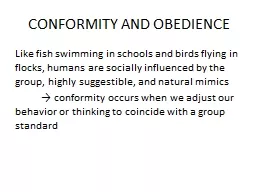

Like fish swimming in schools and birds flying in flocks humans are socially influenced by the group highly suggestible and natural mimics conformity occurs when we adjust our behavior or thinking to coincide with a group standard ID: 778430
Download The PPT/PDF document "CONFORMITY AND OBEDIENCE" is the property of its rightful owner. Permission is granted to download and print the materials on this web site for personal, non-commercial use only, and to display it on your personal computer provided you do not modify the materials and that you retain all copyright notices contained in the materials. By downloading content from our website, you accept the terms of this agreement.
Slide1
CONFORMITY AND OBEDIENCE
Like fish swimming in schools and birds flying in flocks, humans are socially influenced by the group, highly suggestible, and natural mimics
→ conformity occurs when we adjust our behavior or thinking to coincide with a group standard
Slide2CONFORMITY
Solomon Asch conducted the classic experiments on conformity during the 1950s using male college undergraduates
→ after observing multiple co-subjects (actually accomplices of the experiment) give obviously wrong answers, more than one-third of the subjects ‘conformed’ by also giving the wrong answer
Slide3CONFORMITY
Later research found the following determinants making conformity more likely:
Groups are at least three people
Groups are unanimous (one dissenter breaks the spell)Subjects are made to feel incompetent/insecure and admire the group’s status
Subjects know they are being observed
Slide4CONFORMITY
Two separate processes have been identified to explain why we conform:
1) Normative social influence
→ results from a person’s desire to gain approval or avoid disapproval (sensitivity to social norms)2) Informational social influence
→ results from one’s willingness to accept others’ opinions about reality (the desire to be accurate)
Slide5OBEDIENCE
The classic study on obedience was done in the 1960s by Stanley Milgram (student of Asch) who wanted to determine to what extent people would be willing to follow orders
→ conducted at Yale University, Milgram recruited participants to be either the ‘teacher’ or the ‘student’…though it was rigged that they would be the teacher
Slide6OBEDIENCE
→ as the ‘teacher’ they were to deliver a series of escalating ‘shocks’ to the ‘student’ (an accomplice) whenever he made a mistake
Slide7OBEDIENCE
→ as the ‘voltage’ increased, the ‘student’ began to cry in agony and bang the wall, but the ‘experimenter’ instructed the ‘teacher’ to continue
Slide8OBEDIENCE
→ the majority (26) of the (40) ‘teachers’ continued ‘shocking’ the ‘students’ through the entire series of shocks, showing considerable distress while doing so
Slide9OBEDIENCE
Milgram concluded that almost anybody can be coerced into inflicting harm on others under the right circumstances
→ situational factors that decreased obedience in follow-up trials included, 1) separating the study from the prestige of Yale, 2) limiting the perceived authority of the experimenter, 3) involving a role model/supporter for defiance
Slide10OBEDIENCE
Beyond questioning the generalizability (does it apply to real-world situations?) of his study, Milgram’s critics pointed out the ethical issues involved
→ Milgram argued that despite the stress and deception, no subjects showed regret or long-term emotional damage
Slide11OBEDIENCE
→ an updated version (2009) of the study by Jerry Burger modified it for modern ethical standards, but came up with similar results
Slide12OBEDIENCE
The conformity and obedience rates found in Asch’ and Milgram’s studies, respectively have not been found to be unique to the U.S.
→ in particular, and predictably, conformity rates have been found to be higher in collectivist countries